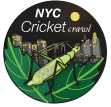| Cricket Crawl | Top | Instructions | Downloadable Data Form | Discover Life |
 The Lost Katydid of New York City The Lost Katydid of New York City Pterophylla camellifolia - The Common (or Northern) True Katydid
Greetings, the rest of this page is an archived version of what we had put up for the Common True Katydid prior to the survey. We are leaving it as is for the time being.
We are starting a new page for the species that will further document the distribution of this species across the City.
Check out the map for this species based on the results of the survey. News Flash! Common True Katydids just found in a residual mature woodland on the grounds of the NY Botanical Garden in the Bronx. A while back, during a casual katydid sort of conversation, Leo Shapiro (meadow katydid researcher) mentioned that he had run across an obscure article in the Journal of the New York Entomological Society. This short article (available here ) is a good example of why someone who knows their natural history should be treasured. Published in 1920, William T. Davis , a native Staten Islander, had noticed that, while formerly present on Staten Island, the loud and omnipresent Common True Katydids now appeared to be completely absent. Subsequent to the publication of that small article, we are unaware of any further survey, study, or note regarding the status of crickets and katydids in the NYC area. One interesting observation in that article was that while Common True Katydids were found to be absent on Staten Island, another naturalist had noted that tall trees near Broadway and 255th still held a few individuals. Now, back to the present tense, you (the reader) in one night's easy work, can help determine the status of Common True Katydids in the New York City area by participating in our count. A couple of things about Common True Katydids are relevant here. From a recent paper (Journal of Orthoptera Research 18: 15-18) it was noted that this species calls continuously when the weather is warm and, of course, it is dark out. This is an excellent characteristic for something you would like to survey, and means that if a Common True Katydid were around you would know it because it would be calling. As an aside, wouldn't it be unnerving if cockroaches were also that detectable? OK, back to katydids... in recent field work in downtown and suburban Washington D.C., Common True Katydids were found commonly in residual woodlots throughout the city (even the "bad" parts of town had "good" numbers). Interestingly, they never occurried where people occurred. Put a house in a woodlot and they were gone... they existed only in parklands. So, are there Common True Katydids in the NYC area? If so, where? Help us to find out (you can even go out on your own before the count...why hold back?).
Well, what are you waiting for? Do you think that watching the Discover Channel is helping us save the planet? Step outside and make a real contribution and figure out what crickets and katydids are calling in your neighborhood. Sheesh. |
Only a few human beings should grow to the square mile; they are commonly planted too close. - William T. Davis
|
|
The Scientific InvestigatorH.L. Mencken The value the world sets upon motives is often grossly unjust and inaccurate. Consider, for example, two of them: mere insatiable curiosity and the desire to do good. The latter is put high above the former, and yet it is the former that moves one of the most useful men the human race has yet produced: the scientific investigator. What actually urges him on is not some brummagem idea of Service, but a boundless, almost pathological thirst to penetrate the unknown, to uncover the secret, to find out what has not been found out before. His prototype is not the liberator releasing slaves, the good Samaritan lifting up the fallen, but a dog sniffing tremendously at an infinite series of rat-holes. | |
| Cricket Crawl | Top | Instructions | Downloadable Data Form | Discover Life |